Yaya Shi
iMOVE: Instance-Motion-Aware Video Understanding
Feb 18, 2025



Abstract:Enhancing the fine-grained instance spatiotemporal motion perception capabilities of Video Large Language Models is crucial for improving their temporal and general video understanding. However, current models struggle to perceive detailed and complex instance motions. To address these challenges, we have made improvements from both data and model perspectives. In terms of data, we have meticulously curated iMOVE-IT, the first large-scale instance-motion-aware video instruction-tuning dataset. This dataset is enriched with comprehensive instance motion annotations and spatiotemporal mutual-supervision tasks, providing extensive training for the model's instance-motion-awareness. Building on this foundation, we introduce iMOVE, an instance-motion-aware video foundation model that utilizes Event-aware Spatiotemporal Efficient Modeling to retain informative instance spatiotemporal motion details while maintaining computational efficiency. It also incorporates Relative Spatiotemporal Position Tokens to ensure awareness of instance spatiotemporal positions. Evaluations indicate that iMOVE excels not only in video temporal understanding and general video understanding but also demonstrates significant advantages in long-term video understanding.
MIBench: Evaluating Multimodal Large Language Models over Multiple Images
Jul 21, 2024



Abstract:Built on the power of LLMs, numerous multimodal large language models (MLLMs) have recently achieved remarkable performance on various vision-language tasks across multiple benchmarks. However, most existing MLLMs and benchmarks primarily focus on single-image input scenarios, leaving the performance of MLLMs when handling realistic multiple images remain underexplored. Although a few benchmarks consider multiple images, their evaluation dimensions and samples are very limited. Therefore, in this paper, we propose a new benchmark MIBench, to comprehensively evaluate fine-grained abilities of MLLMs in multi-image scenarios. Specifically, MIBench categorizes the multi-image abilities into three scenarios: multi-image instruction (MII), multimodal knowledge-seeking (MKS) and multimodal in-context learning (MIC), and constructs 13 tasks with a total of 13K annotated samples. During data construction, for MII and MKS, we extract correct options from manual annotations and create challenging distractors to obtain multiple-choice questions. For MIC, to enable an in-depth evaluation, we set four sub-tasks and transform the original datasets into in-context learning formats. We evaluate several open-source MLLMs and close-source MLLMs on the proposed MIBench. The results reveal that although current models excel in single-image tasks, they exhibit significant shortcomings when faced with multi-image inputs, such as confused fine-grained perception, limited multi-image reasoning, and unstable in-context learning. The annotated data in MIBench is available at https://huggingface.co/datasets/StarBottle/MIBench.
Semantics-enhanced Cross-modal Masked Image Modeling for Vision-Language Pre-training
Mar 01, 2024Abstract:In vision-language pre-training (VLP), masked image modeling (MIM) has recently been introduced for fine-grained cross-modal alignment. However, in most existing methods, the reconstruction targets for MIM lack high-level semantics, and text is not sufficiently involved in masked modeling. These two drawbacks limit the effect of MIM in facilitating cross-modal semantic alignment. In this work, we propose a semantics-enhanced cross-modal MIM framework (SemMIM) for vision-language representation learning. Specifically, to provide more semantically meaningful supervision for MIM, we propose a local semantics enhancing approach, which harvest high-level semantics from global image features via self-supervised agreement learning and transfer them to local patch encodings by sharing the encoding space. Moreover, to achieve deep involvement of text during the entire MIM process, we propose a text-guided masking strategy and devise an efficient way of injecting textual information in both masked modeling and reconstruction target acquisition. Experimental results validate that our method improves the effectiveness of the MIM task in facilitating cross-modal semantic alignment. Compared to previous VLP models with similar model size and data scale, our SemMIM model achieves state-of-the-art or competitive performance on multiple downstream vision-language tasks.
Unifying Latent and Lexicon Representations for Effective Video-Text Retrieval
Feb 26, 2024Abstract:In video-text retrieval, most existing methods adopt the dual-encoder architecture for fast retrieval, which employs two individual encoders to extract global latent representations for videos and texts. However, they face challenges in capturing fine-grained semantic concepts. In this work, we propose the UNIFY framework, which learns lexicon representations to capture fine-grained semantics and combines the strengths of latent and lexicon representations for video-text retrieval. Specifically, we map videos and texts into a pre-defined lexicon space, where each dimension corresponds to a semantic concept. A two-stage semantics grounding approach is proposed to activate semantically relevant dimensions and suppress irrelevant dimensions. The learned lexicon representations can thus reflect fine-grained semantics of videos and texts. Furthermore, to leverage the complementarity between latent and lexicon representations, we propose a unified learning scheme to facilitate mutual learning via structure sharing and self-distillation. Experimental results show our UNIFY framework largely outperforms previous video-text retrieval methods, with 4.8% and 8.2% Recall@1 improvement on MSR-VTT and DiDeMo respectively.
mPLUG-PaperOwl: Scientific Diagram Analysis with the Multimodal Large Language Model
Nov 30, 2023



Abstract:Recently, the strong text creation ability of Large Language Models(LLMs) has given rise to many tools for assisting paper reading or even writing. However, the weak diagram analysis abilities of LLMs or Multimodal LLMs greatly limit their application scenarios, especially for scientific academic paper writing. In this work, towards a more versatile copilot for academic paper writing, we mainly focus on strengthening the multi-modal diagram analysis ability of Multimodal LLMs. By parsing Latex source files of high-quality papers, we carefully build a multi-modal diagram understanding dataset M-Paper. By aligning diagrams in the paper with related paragraphs, we construct professional diagram analysis samples for training and evaluation. M-Paper is the first dataset to support joint comprehension of multiple scientific diagrams, including figures and tables in the format of images or Latex codes. Besides, to better align the copilot with the user's intention, we introduce the `outline' as the control signal, which could be directly given by the user or revised based on auto-generated ones. Comprehensive experiments with a state-of-the-art Mumtimodal LLM demonstrate that training on our dataset shows stronger scientific diagram understanding performance, including diagram captioning, diagram analysis, and outline recommendation. The dataset, code, and model are available at https://github.com/X-PLUG/mPLUG-DocOwl/tree/main/PaperOwl.
Youku-mPLUG: A 10 Million Large-scale Chinese Video-Language Dataset for Pre-training and Benchmarks
Jun 07, 2023Abstract:To promote the development of Vision-Language Pre-training (VLP) and multimodal Large Language Model (LLM) in the Chinese community, we firstly release the largest public Chinese high-quality video-language dataset named Youku-mPLUG, which is collected from Youku, a well-known Chinese video-sharing website, with strict criteria of safety, diversity, and quality. Youku-mPLUG contains 10 million Chinese video-text pairs filtered from 400 million raw videos across a wide range of 45 diverse categories for large-scale pre-training. In addition, to facilitate a comprehensive evaluation of video-language models, we carefully build the largest human-annotated Chinese benchmarks covering three popular video-language tasks of cross-modal retrieval, video captioning, and video category classification. Youku-mPLUG can enable researchers to conduct more in-depth multimodal research and develop better applications in the future. Furthermore, we release popular video-language pre-training models, ALPRO and mPLUG-2, and our proposed modularized decoder-only model mPLUG-video pre-trained on Youku-mPLUG. Experiments show that models pre-trained on Youku-mPLUG gain up to 23.1% improvement in video category classification. Besides, mPLUG-video achieves a new state-of-the-art result on these benchmarks with 80.5% top-1 accuracy in video category classification and 68.9 CIDEr score in video captioning, respectively. Finally, we scale up mPLUG-video based on the frozen Bloomz with only 1.7% trainable parameters as Chinese multimodal LLM, and demonstrate impressive instruction and video understanding ability. The zero-shot instruction understanding experiment indicates that pretraining with Youku-mPLUG can enhance the ability to comprehend overall and detailed visual semantics, recognize scene text, and leverage open-domain knowledge.
mPLUG-Owl: Modularization Empowers Large Language Models with Multimodality
Apr 27, 2023



Abstract:Large language models (LLMs) have demonstrated impressive zero-shot abilities on a variety of open-ended tasks, while recent research has also explored the use of LLMs for multi-modal generation. In this study, we introduce mPLUG-Owl, a novel training paradigm that equips LLMs with multi-modal abilities through modularized learning of foundation LLM, a visual knowledge module, and a visual abstractor module. This approach can support multiple modalities and facilitate diverse unimodal and multimodal abilities through modality collaboration. The training paradigm of mPLUG-Owl involves a two-stage method for aligning image and text, which learns visual knowledge with the assistance of LLM while maintaining and even improving the generation abilities of LLM. In the first stage, the visual knowledge module and abstractor module are trained with a frozen LLM module to align the image and text. In the second stage, language-only and multi-modal supervised datasets are used to jointly fine-tune a low-rank adaption (LoRA) module on LLM and the abstractor module by freezing the visual knowledge module. We carefully build a visually-related instruction evaluation set OwlEval. Experimental results show that our model outperforms existing multi-modal models, demonstrating mPLUG-Owl's impressive instruction and visual understanding ability, multi-turn conversation ability, and knowledge reasoning ability. Besides, we observe some unexpected and exciting abilities such as multi-image correlation and scene text understanding, which makes it possible to leverage it for harder real scenarios, such as vision-only document comprehension. Our code, pre-trained model, instruction-tuned models, and evaluation set are available at https://github.com/X-PLUG/mPLUG-Owl. The online demo is available at https://www.modelscope.cn/studios/damo/mPLUG-Owl.
mPLUG-2: A Modularized Multi-modal Foundation Model Across Text, Image and Video
Feb 01, 2023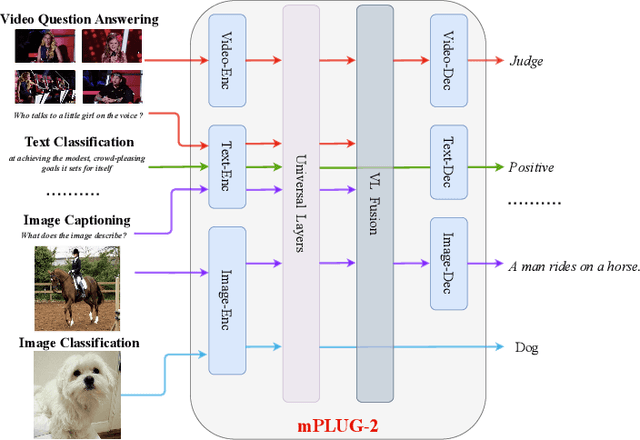

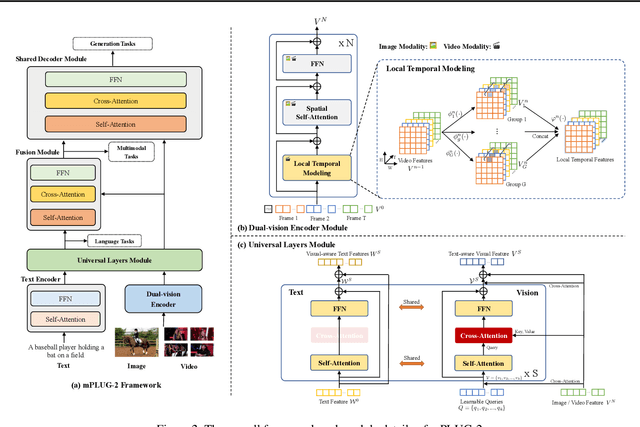

Abstract:Recent years have witnessed a big convergence of language, vision, and multi-modal pretraining. In this work, we present mPLUG-2, a new unified paradigm with modularized design for multi-modal pretraining, which can benefit from modality collaboration while addressing the problem of modality entanglement. In contrast to predominant paradigms of solely relying on sequence-to-sequence generation or encoder-based instance discrimination, mPLUG-2 introduces a multi-module composition network by sharing common universal modules for modality collaboration and disentangling different modality modules to deal with modality entanglement. It is flexible to select different modules for different understanding and generation tasks across all modalities including text, image, and video. Empirical study shows that mPLUG-2 achieves state-of-the-art or competitive results on a broad range of over 30 downstream tasks, spanning multi-modal tasks of image-text and video-text understanding and generation, and uni-modal tasks of text-only, image-only, and video-only understanding. Notably, mPLUG-2 shows new state-of-the-art results of 48.0 top-1 accuracy and 80.3 CIDEr on the challenging MSRVTT video QA and video caption tasks with a far smaller model size and data scale. It also demonstrates strong zero-shot transferability on vision-language and video-language tasks. Code and models will be released in https://github.com/alibaba/AliceMind.
EMScore: Evaluating Video Captioning via Coarse-Grained and Fine-Grained Embedding Matching
Nov 17, 2021

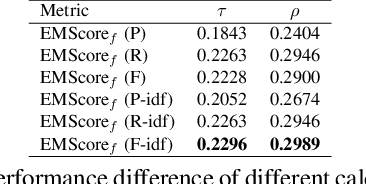

Abstract:Current metrics for video captioning are mostly based on the text-level comparison between reference and candidate captions. However, they have some insuperable drawbacks, e.g., they cannot handle videos without references, and they may result in biased evaluation due to the one-to-many nature of video-to-text and the neglect of visual relevance. From the human evaluator's viewpoint, a high-quality caption should be consistent with the provided video, but not necessarily be similar to the reference in literal or semantics. Inspired by human evaluation, we propose EMScore (Embedding Matching-based score), a novel reference-free metric for video captioning, which directly measures similarity between video and candidate captions. Benefit from the recent development of large-scale pre-training models, we exploit a well pre-trained vision-language model to extract visual and linguistic embeddings for computing EMScore. Specifically, EMScore combines matching scores of both coarse-grained (video and caption) and fine-grained (frames and words) levels, which takes the overall understanding and detailed characteristics of the video into account. Furthermore, considering the potential information gain, EMScore can be flexibly extended to the conditions where human-labeled references are available. Last but not least, we collect VATEX-EVAL and ActivityNet-FOIl datasets to systematically evaluate the existing metrics. VATEX-EVAL experiments demonstrate that EMScore has higher human correlation and lower reference dependency. ActivityNet-FOIL experiment verifies that EMScore can effectively identify "hallucinating" captions. The datasets will be released to facilitate the development of video captioning metrics. The code is available at: https://github.com/ShiYaya/emscore.
A Simple and Strong Baseline for Universal Targeted Attacks on Siamese Visual Tracking
May 06, 2021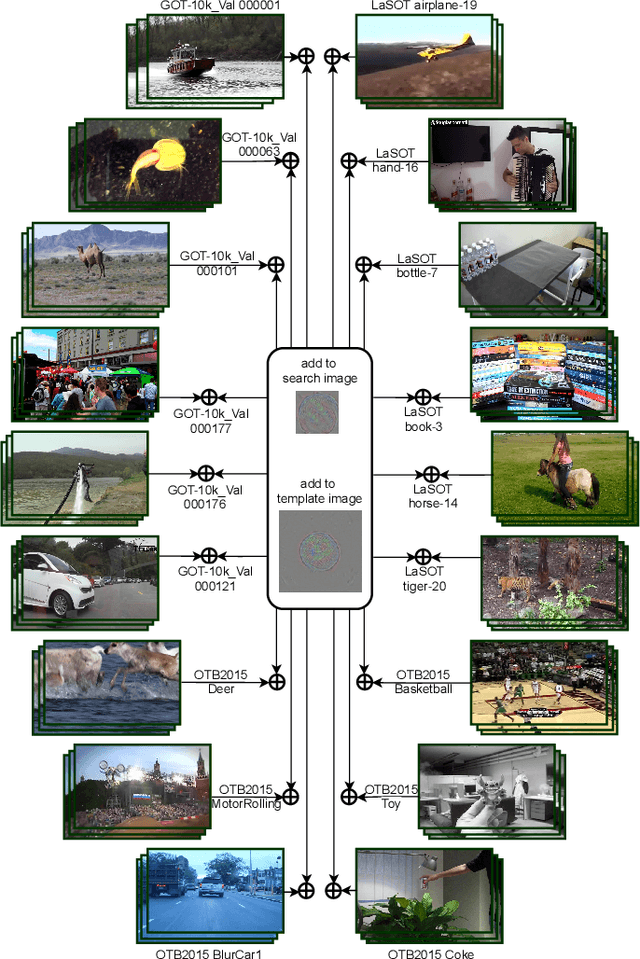
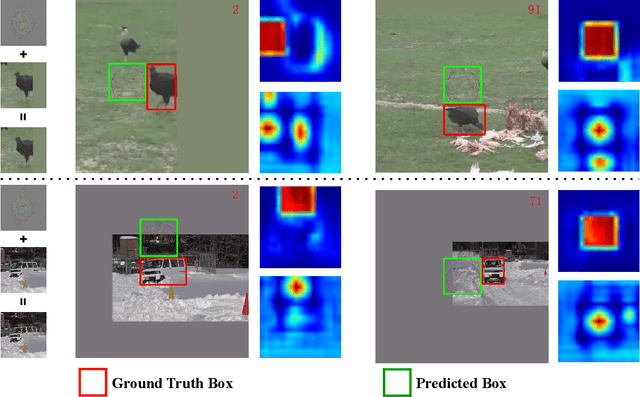
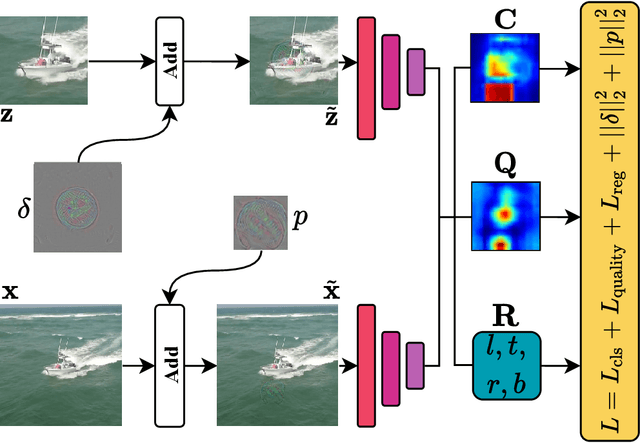
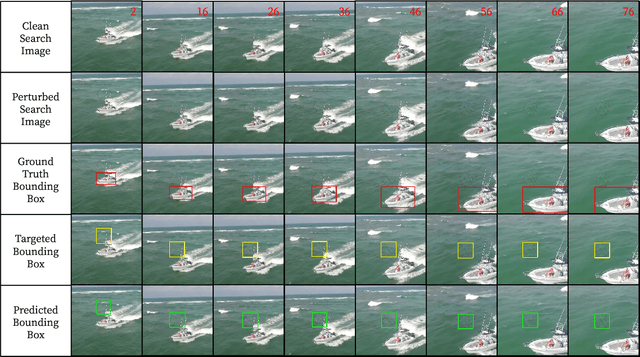
Abstract:Siamese trackers are shown to be vulnerable to adversarial attacks recently. However, the existing attack methods craft the perturbations for each video independently, which comes at a non-negligible computational cost. In this paper, we show the existence of universal perturbations that can enable the targeted attack, e.g., forcing a tracker to follow the ground-truth trajectory with specified offsets, to be video-agnostic and free from inference in a network. Specifically, we attack a tracker by adding a universal imperceptible perturbation to the template image and adding a fake target, i.e., a small universal adversarial patch, into the search images adhering to the predefined trajectory, so that the tracker outputs the location and size of the fake target instead of the real target. Our approach allows perturbing a novel video to come at no additional cost except the mere addition operations -- and not require gradient optimization or network inference. Experimental results on several datasets demonstrate that our approach can effectively fool the Siamese trackers in a targeted attack manner. We show that the proposed perturbations are not only universal across videos, but also generalize well across different trackers. Such perturbations are therefore doubly universal, both with respect to the data and the network architectures. We will make our code publicly available.
 Add to Chrome
Add to Chrome Add to Firefox
Add to Firefox Add to Edge
Add to Edge